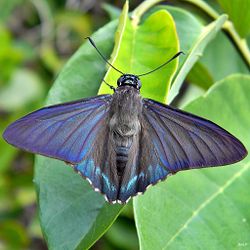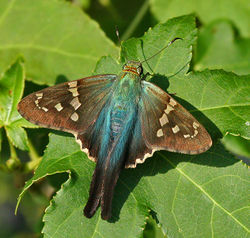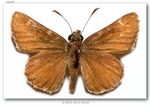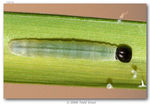Skipper
| Skipper |
|---|

|
| Scientific Classification |
|
| Subfamilies |
| Image Description |
Skippers are any of the species of insects belonging to the taxonomic family Hesperiidae. Though they are relatively close to butterflies and moths in looks and life cycles, they are different. There are many different types of skippers. People will tell them apart by the way they hold their wings in the sun, and because their flight patterns look like they are skipping around. Though these insects are small, they are beautiful little creatures designed by God. “And to all the beasts of the earth and all the birds in the sky and all the creatures that move along the ground—everything that has the breath of life in it—I give every green plant for food.” And it was so."(Genesis 1:30 NIV)
Body Design
Skippers are usually small in size and very fast. They are not easy to recognize because they travel so quickly. Some people identify them by how they hold their wings in the sun. If they have wings in the front and back that are partially open they are branded skippers. These insects usually have colors like orange, rust, or brown. Then there are the spread-winged skippers whose colors are brown, black, or checkered. These skippers keep their four wings wide open. [2].
The rest of a skipper's body is close to a butterfly's. They have a head, thorax, and abdomen. On the head they have two antennae, two compound eyes and one proboscis. Also, on the thorax the skippers have six legs and four wings. Lastly, the abdomen consists of a digestive tract, spiracles, and reproductive organs. [3].
Life Cycle
Skippers go through complete metamorphosis just like butterflies. This means they undergo four different stages. First, the mother lays her eggs under a leaf on a host plant. Then from the egg emerges a Caterpillar. Next these caterpillars will eat and eat until it is time for them to transform.
After they gain enough nutrients to last a long time, the caterpillar goes into a leaf shelter or a silk cocoon. The skipper pupae being held by only a silk girdle, can attach to a twig or branch. In the cocoon the Skipper will change from a pupae to an adult. Finally when the skipper emerges from the cocoon it is in its adult form.[4] From here the adult can find a mate and reproduce. Then the cycle will start over again.
Ecology
The family Hesperiidae lives all around the world. There are approximately three hundred species of them alone.[5] Skippers can be found in many different habitats. Though, they are usually found at the edges of woodlands and in meadows. Their habitat regions include temperate, tropical, and terrestrial. They are found in these terrestrial biomes; taiga, desert or dune, chaparral, forest, rainforest, scrub forest, and mountains. They can also be found in wetland such as swamps and marshes.[6]
Skipper caterpillars eat grasses, reeds, shrubs or trees. These insects have to stay close to places with these foods in order for the caterpillars to survive. Different types of caterpillars eat different groups of plants. Adult skippers drink nectar and mud. They drink mud for the minerals in it. All in all they are herbivores. The family Hesperiidae also has predators. They even have predators for different stages in life. The eggs are eaten by mites, green lacewings, lady beetles. The caterpillars are food to parasitic flies, ants, and wasps. Their pupas can be eaten by shrews and mice. The predators include mantis, wasps, frogs, toads, and spider(particularly crab spiders and orb-weavers). All are eaten by insect-eating birds. For protection caterpillars are camouflaged and usually are hiding during the day. They are camouflaged by how their skin blends in with the leaves. The only safety adult skippers have is flying fast. In conclusion skippers are herbivores living in meadows and woodlands,they have a ton of predators, and have to depend on fast escapes.[7]
Other Interesting Facts
First of all, the family Hesperiidae are called "Skippers" for a great reason. They are called this because they have a fast and spasmodic way of flying. This makes them look like they are skipping from place to place. Another little known fact, a Skipper is not a butterfly at all, but they are part of the order Lepidoptera. They are more related to butterflies in looks and actions than moths.[8] Last interesting fact about skippers is their sexual dimorphism, for skippers the female is larger than the male. Dimorphism is the difference in male and female organisms in their structures.Cite error: Invalid <ref> tag; invalid names, e.g. too many The above-mentioned are a few interesting facts about the insects that are called skippers.
Video
What a Skipper goes through in its life cycle.
Gallery
References
- ↑ Hesperiidae Wikispecies. Web. last-update:30 May 2013 Author Unknown.
- ↑ Everything About Skipper Everything About. Web. accessed December 17, 2013. Author Unknown
- ↑ Parts of a Butterfly Cambridge Butterfly Conservatory. Web. accessed December 17, 2013 Author Unknown .
- ↑ .Hadley, Debbie. Skippers, Family Hesperiidae About.com Insects. Web. accessed January 11, 2014.
- ↑ . Hesperiidae BioKIDS. Web. accessed January 11, 2014 Author Unknown.
- ↑ Hesperiidae Skipper Butterflies Encyclopedia of Life. Web. accessed January 12, 2014. Author Unknown
- ↑ Hesperiidae BioKIDS. Web. accessed January 12, 2014. Author Unknown
- ↑ Hesperiidae: The Skippers Idaho Museum of Natural History. Web. accessed January 12, 2014 Author Unknown.







